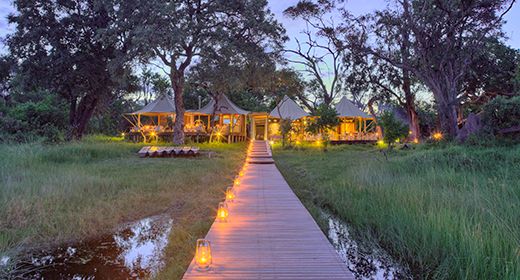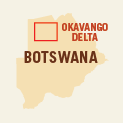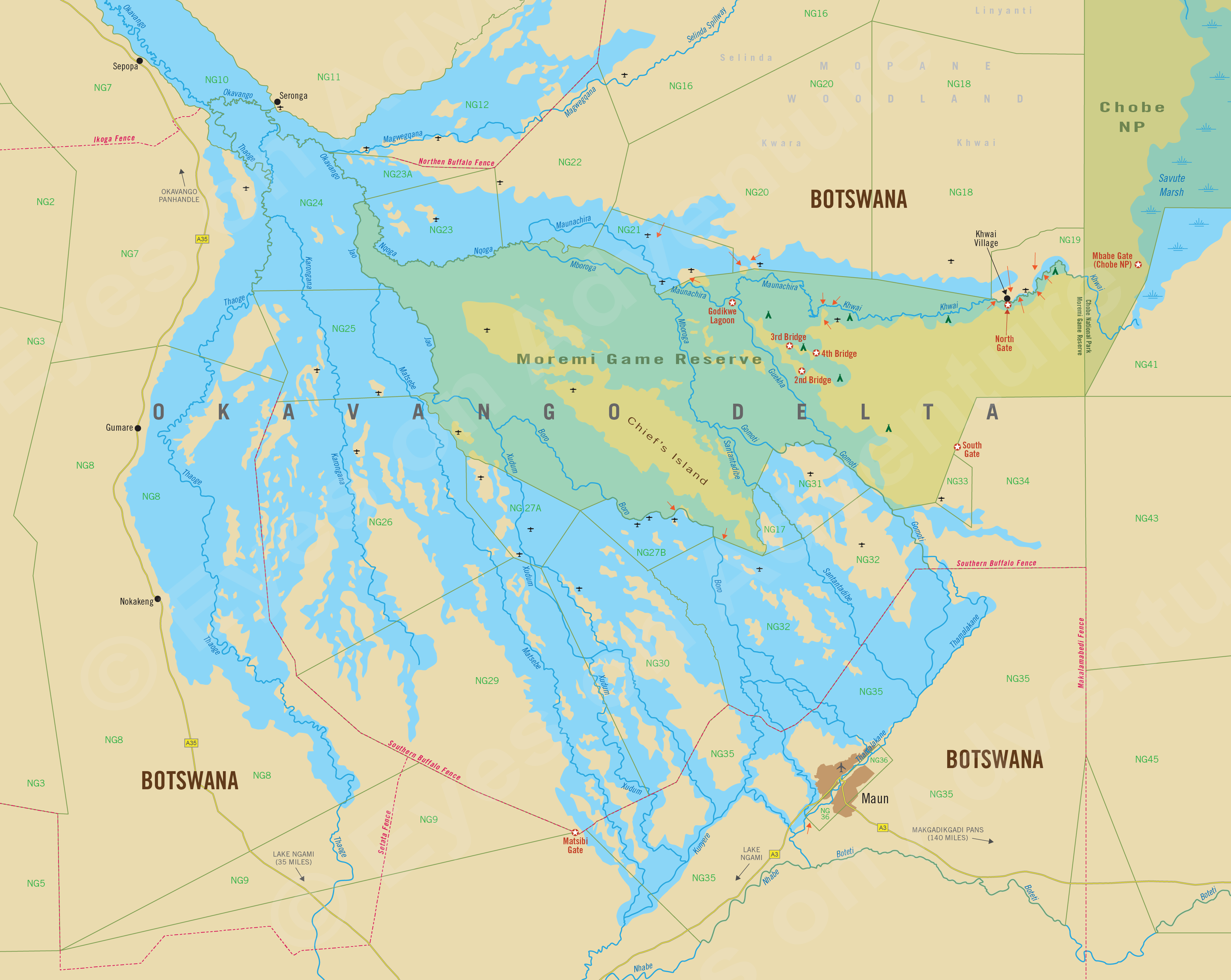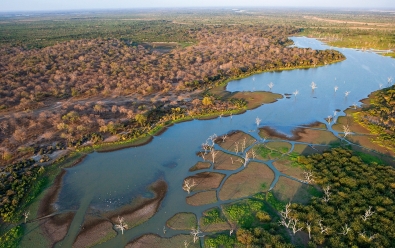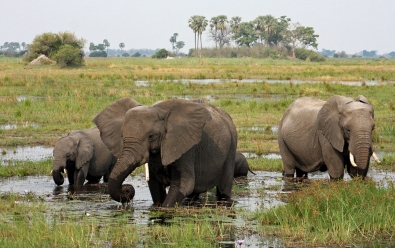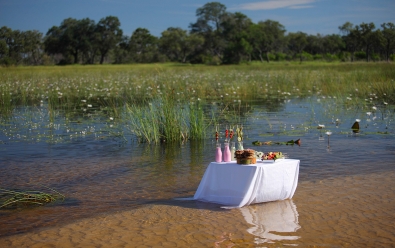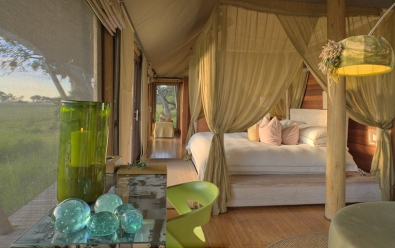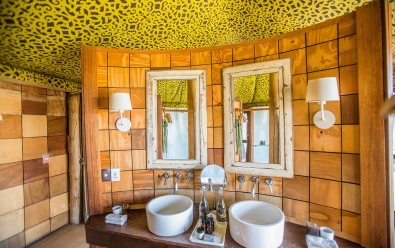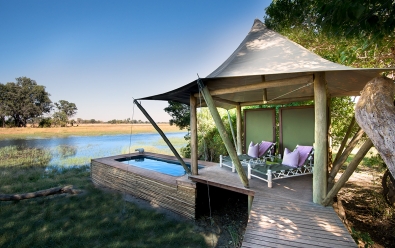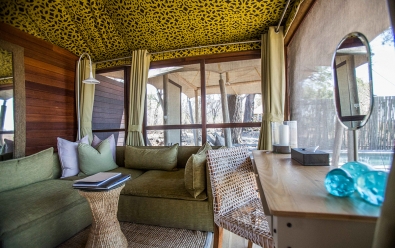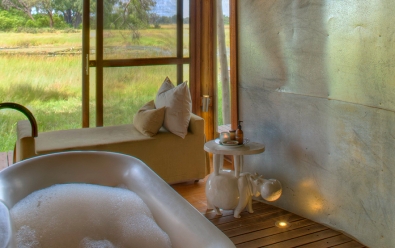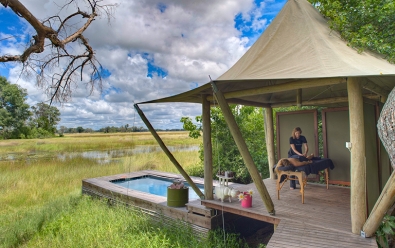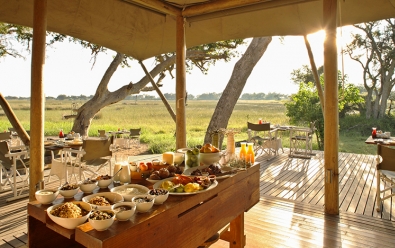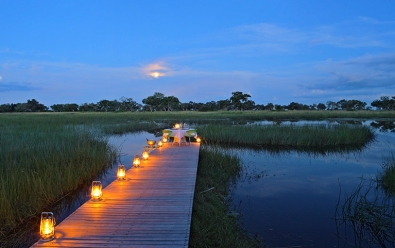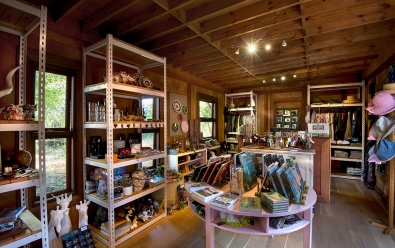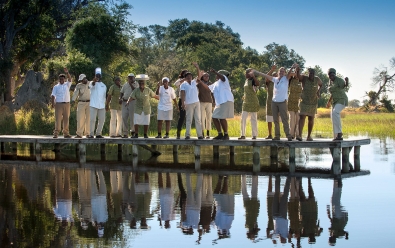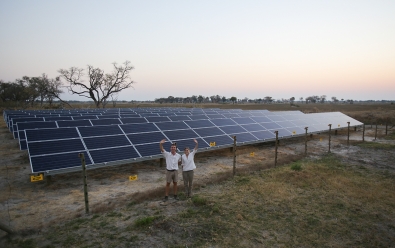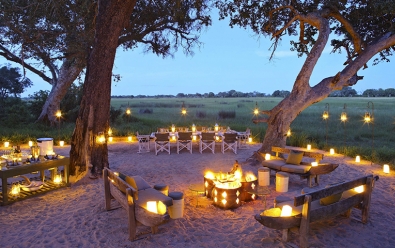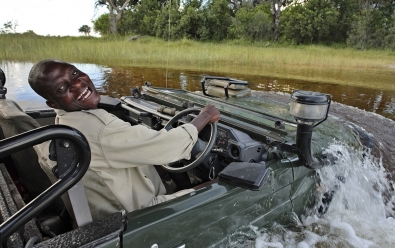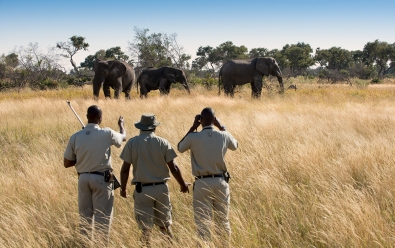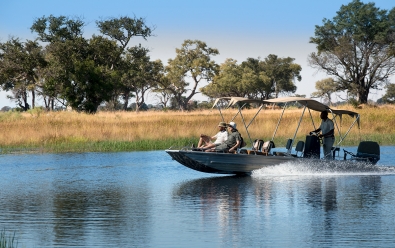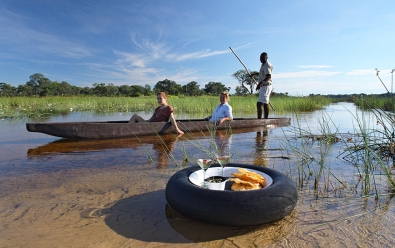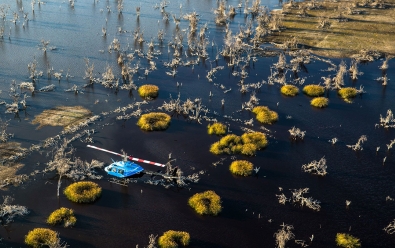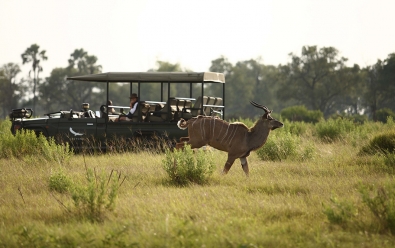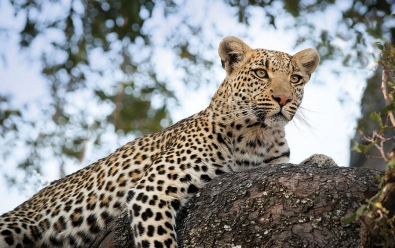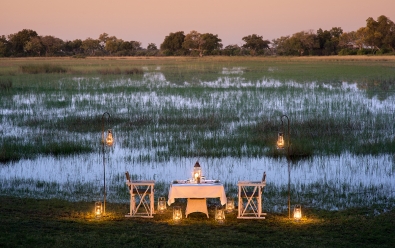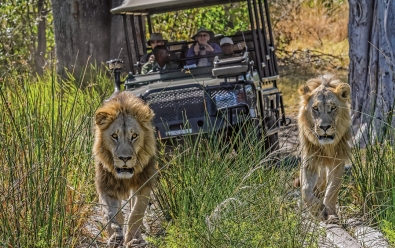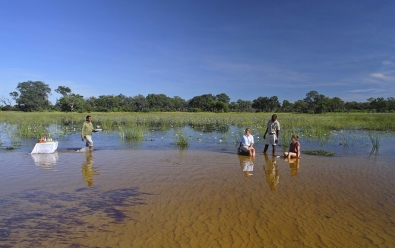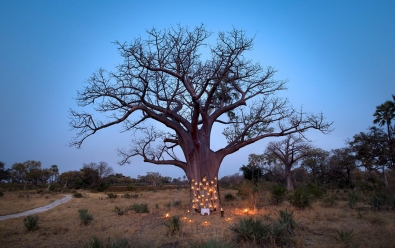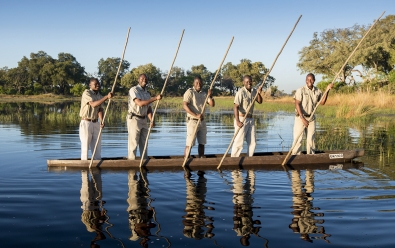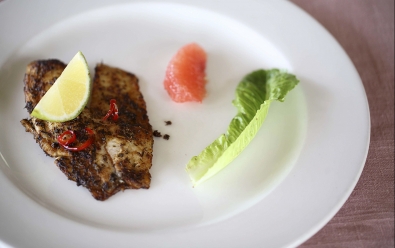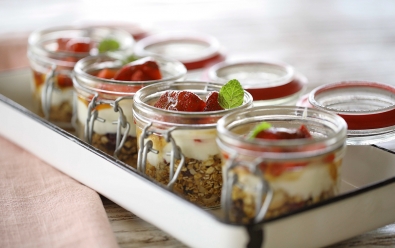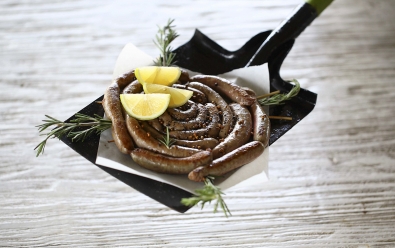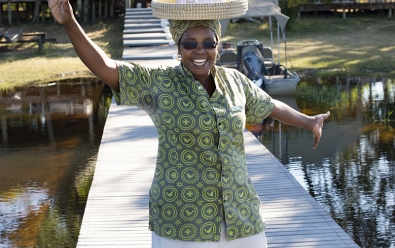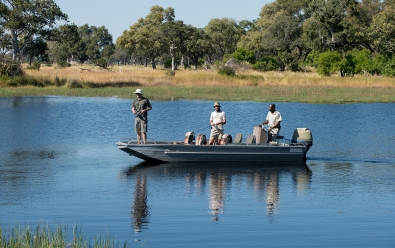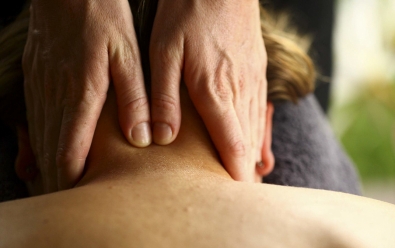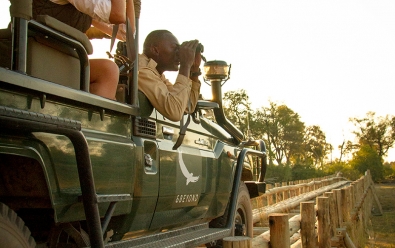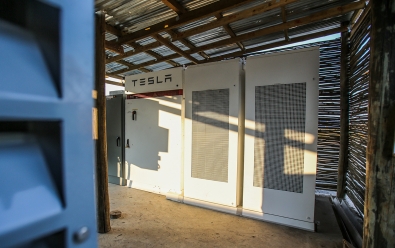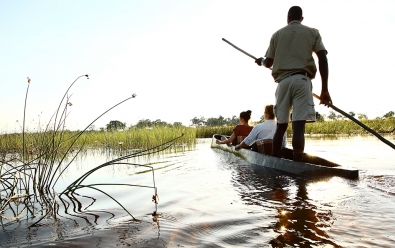Xaranna Camp
Highlights
- Remote location on a secluded island in a true wilderness setting
- Diversity of habitats with land- and water-based activities
- Game drives, walking safaris, boating, fishing, and mokoroing
- The camp operates almost exclusively on solar power
Location
- NG30 Private Concession
- Southern Okavango Delta
- Northern Botswana
Xaranna Camp is located in the southern reaches of the Okavango Delta on its own private island within a massive, exclusive-use wildlife concession.
The camp is situated in solitude on the edge of a seasonal lagoon and floodplain that are well-visited by wildlife. There are no other camps for many miles and guests will enjoy exploring the vast 350-square-mile (905-sq-km) concession surrounding the camp.
The area includes a great diversity of habitats, including dry savanna grasslands, seasonally flooded plains, open woodland mature forest, permanent waterways, palm islands, reed-bed swamps, and papyrus-fringed rivers that ebb and flow depending on the season.
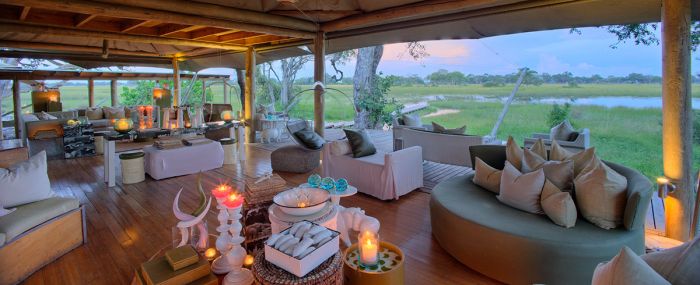
Main area view at Xaranna Camp.
The concession is rich in wildlife, with a very good chance to see at least four of Africa's Big Five (lion, leopard, elephant, and buffalo; rhino is possible but sightings are infrequent). Herbivorous animals seen regularly include red lechwe, plains zebra, giraffe, impala, greater kudu, waterbuck, blue wildebeest, and warthog. Hippo are found in the deeper channels.
Predators around the camp include leopard, lion, spotted hyena, and African wild dog. Crocodile can be seen in the waterways. The birding is excellent, with a typical safari day producing 100+ species, especially during the summer months between November and February, when migratory species are present for breeding.
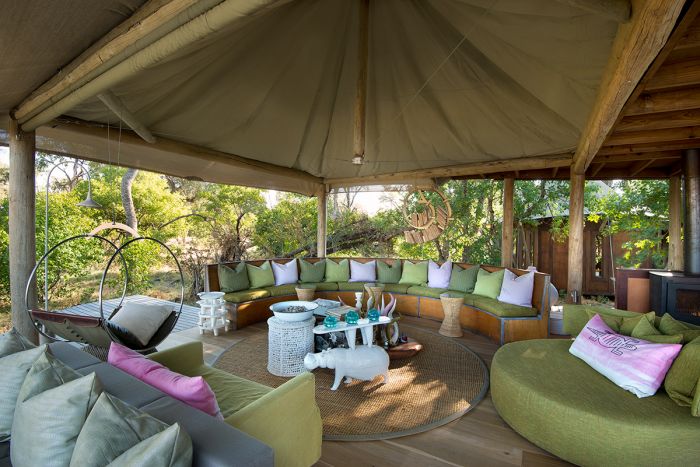
Main area lounge at Xaranna Camp.
Xaranna offers 9 spacious and airy guest suites made from bleached wood, canvas, and mesh, with pastel colors to blend into the natural surroundings. The en-suite facilities include an indoor shower, an al-fresco shower, bath tub, and separate toilet area. A huge private deck includes a sala with day-bed and pool, with views overlooking the floodplain and lagoon. Wellness treatments and massages are offered at the guest suites.
The camp's main guest area includes a semi-open living space constructed atop raised wooden decking under a high-pitched canvas roof. The space includes lounge, dining, and bar areas, with plenty of seating under the roof as well as outside on the viewing deck. A few shallow steps lead down to the jetty, from which boats and mokoros lead to seasonal water-based adventures. The main area also includes a Safari Store and a traditional open-air boma for outdoor dining nights.
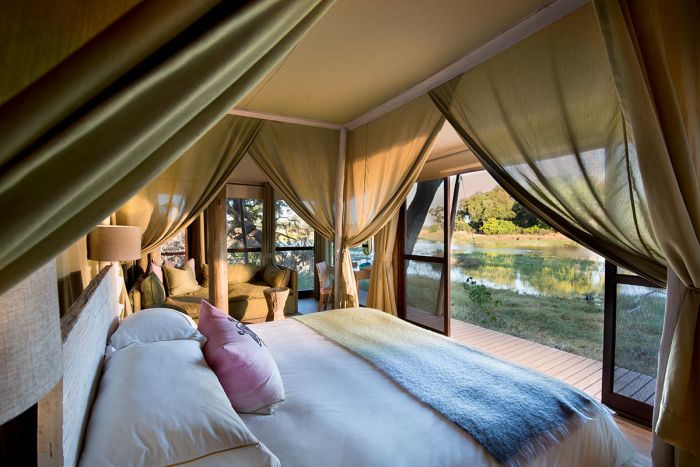
Guest tent interior and view.
Activities at Xaranna include safari game drives in open 4x4 vehicles with a maximum of just six guests per vehicle, allowing for space and unobstructed viewing. Water-levels vary year to year in the Okavango Delta, but Xaranna typically offers mokoro (dugout canoe) excursions and motorized boating during the winter and spring months, as well as catch-and-release fishing. Guided walking safaris and scenic helicopter flights are also on offer.
AndBeyond are one of Africa's leading safari operators and they strive to minimize energy consumption at all their camps. Xaranna is powered by a Tesla Solar-Power Plant that provides the camp with 'green' energy for 80% of its needs (a diesel generator is used for the remainder). Strict eco-friendly environmental standards are maintained so that no harmful chemicals or waste is allowed to enter the pristine ecosystem of the Okavango Delta.
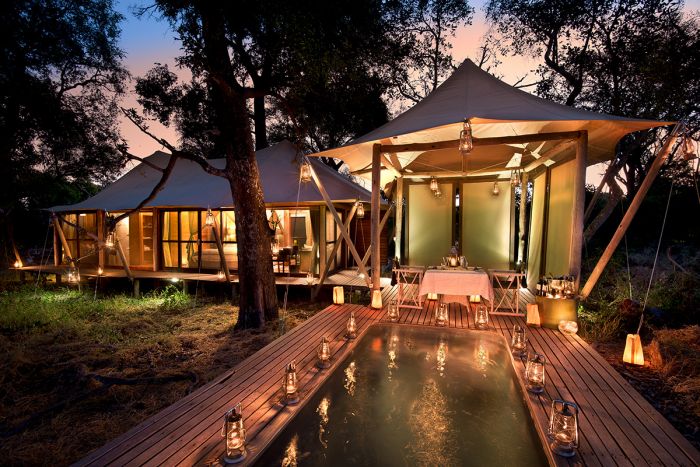
Private dinner in your guest suite.
About the Okavango Delta
The Okavango Delta is one of Africa's greatest safari destinations and offers an incredible diversity and abundance of wildlife. The Okavango is an UNESCO World Heritage Site as well as a Ramsar Wetland of International Importance.
Often referred to simply as "the Delta", the Okavango is characterized by an ever-changing network of waterways that originate far to the northwest in the highlands of Angola. The Cubango River flows into northern Botswana and spills into the flat expanse of Kalahari sands, where it fans out into a shallow trough formed by tectonic faults beneath the sand.
The annual 'flooding' of the Okavango brings in rich sediments that provide nutrients atop the sands, which in turn creates a diverse ecosystem of permanent and seasonal waterways, deep-water lagoons, papyrus beds, palm-covered islands, seasonally flooded grasslands, and woodlands. The rich fresh-water environment changes year-to-year depending on the level of the floodwaters making it one of the most dynamic wildlife destinations on Earth.
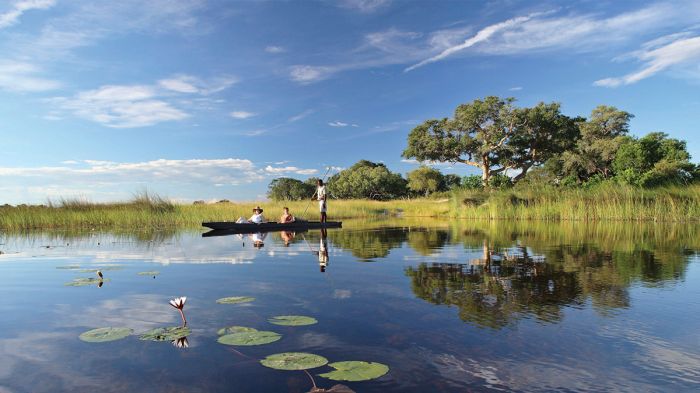
Mokoro outing at Xaranna Camp.
Wildlife in the Okavango Delta is diverse and includes all of Africa's Big Five animals (lion, leopard, elephant, rhino, and buffalo. Commonly seen herbivores include giraffe, plains (Burchell's) zebra, blue wildebeest, impala, tsessebe, common reedbuck, greater kudu, waterbuck, buffalo, elephant, and warthog. Both species of rhino are found, albeit in small numbers. The Delta is also home to red lechwe and sitatunga, both of which are water-dependent antelopes.
The abundance of herbivores means that predators are common in the Okavango. Commonly seen species include lion, leopard, spotted hyena, black-backed jackal, and African wild dog. Cheetah are sometimes seen in the larger grasslands like those on Chief's Island. Less frequently encountered predators include serval, caracal, honey badger, and various species of mongoose.
The abundance of water in the Okavango provides habitat for Nile crocodiles and hippos, both of which are seen easily at any of the safari camps located near the Delta's permanent water. Primates in the Delta include chacma baboon, vervet monkey, and bush baby (galago).
Birding is outstanding in the Delta, with over 400 species possible. A typical safari day can easily produce over 100 species for an avid birder.
ROOMS INCLUDES & EXCLUDES CHILDREN FACILITIES ACTIVITIES
Accommodation
9 guest accommodations in total comprising:
- 9 canvas-tented, temperature-controlled suites, each with two three-quarter beds (separate mattresses with shared four-poster base). Mattress converters are available that transform the beds into a king size beds.
Each guest suite is constructed atop a raised wooden deck and looks out over a floodplain and lagoon. En-suite facilities include a double-basin vanity, indoor shower, al fresco shower, bath tub, and separate toilet. A large outdoor deck includes a private sala, plunge pool and superb views.
The suites are connected to the camp's main area by sandy footpaths on the ground.
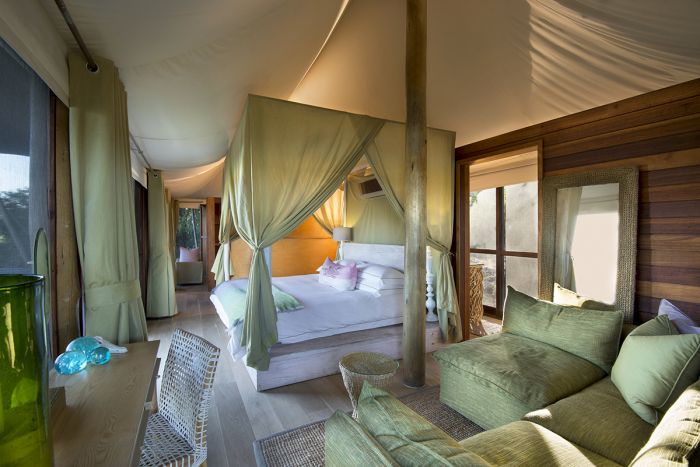
Guest suite interior at Xaranna Camp.
The guest suites are combine canvas, bleached wood, and drapes and have a cool, light, and airy feel that blends into the natural surroundings. Large sliding doors with mesh screening open onto a massive private deck that overlooks a seasonal floodplain and lagoon. Each suite is 1 012 square feet (94 sq meters) in area. The distance between guest suites is approximately 98 feet (30 meters).
Other items and features in the guest suites include:
- Lounge area with a comfortable couch.
- Air conditioning and heating.
- Spacious deck with private sala and pool.
- Writing desk and chair.
- Mini-bar with craft “Hope on Hopkins” vodka and Absolut’s raspberry flavored vodka, which are accompanied with premium Franklin & Sons mixers.
- Complimentary pair of Swarovski binoculars (one per suite).
- In-room Wi-Fi.
- Mosquito netting for the bed.
- Ceiling fan.
- Telephone.
- Hairdryer.
- In-room safe.
Xaranna Camp can accommodate a maximum of 18 guests in total: 2 persons in each of the 9 guest suites.
Includes & Excludes
Includes:
- All meals and local beverages including soft drinks, house wines, local brand spirits and beers, teas, and coffees.
- Safari experiences (game drives, walking safaris, motorized boat cruises, mokoro outings, seasonal catch-and-release fishing, and birding) accompanied by an experienced guide. Note that water-based activities are dependent on water levels.
- Africa Foundation community visit.
- Back-of-house sustainability tour.
- Guides' Journal with illustrations of fauna and flora to record your sightings.
- Concession map with Nxabega's illustrated Star Birds checklist.
- Laundry services are provided on a daily basis (weather permitting, items will be returned on the same day). Laundry is dried by the sun and on most days any laundry placed out in the morning will be returned by the evening.
- A complimentary pair of Swarovski Optik CL Companion 8×30 binoculars per room for use during your stay.
- Emergency medical evacuation insurance.
- Wi-Fi access.
- Tourism Levy & VAT.
Excludes:
- Purchases from the Safari Shop.
- Champagne, cognacs, fine wines, premium brand spirits, and cigars.
- Spa / wellness treatments.
- Scenic helicopter flights.
- Any applicable wildlife fee, park fee, reserve fee, concession fee, other land-use fee.
Single Supplement
A single supplement may apply for any room booked by a single traveler; please ask us for pricing.
Children
Families can rest assured that your children will always be safe and well cared for (both during activities and at the lodge) by the lodge staff.
Children of all ages are accommodated at Xaranna:
- 1 tented triple suite available - max 2 adults and 1 child under 12 years.
- Safari walks for children at the discretion of the Lodge Manager.
AndBeyond’s WILDchild programme, designed especially for children, is filled with fun, interactive activities that offer opportunities to learn and discover new experiences and cultures. Deeply rooted in the love for the African bush, it not only creates a series of unforgettable moments for the whole family, but forges strong bonds between young guests, our planet, and its people.
Facilities
Main guest area facilities include:
- The main area comprises a canvas and wood semi-open design with a high-pitched, open-truss ceiling frame, an expansive indoor and outdoor lounge, a dinging area, and a bar.
- A jetty extends from the main tented area for access to the boats and mokoros.
- No main area pool as each guest suite has its own private pool.
- Open-air boma for outdoor dining nights.
- Massage treatments offered at guest suites.
- Safari Store.
- Solar photovoltaic (PV) plant and a Tesla Powerpack Battery Energy Storage System (BESS) has enabled the lodge to operate on an energy ratio of 80% renewable 'green' energy.
- Complimentary Wi-Fi access (in guest suites).
- Guest toilets in main area.
Activities
Activities included in the rate:
- Daytime game drives in open 9-seater 4x4 Land Cruisers (max six guests per vehicle).
- A complimentary pair of Swarovski Optik CL Companion 8×30 binoculars per room for use during your stay.
- Guided walking safaris.
- Mokoro (dugout canoe) excursions (seasonal and water levels permitting). Note that water levels fluctuate and are never certain, but mokoroing is generally possible from May through mid-October.
- Motorized boat cruises (seasonal and water levels permitting). Note that water levels fluctuate and are never certain, but boating is generally possible from May through mid-September.
- Fishing on a catch-and-release basis year round (except January and February, when fishing is barred by law for breeding).
- Birding.
- Africa Foundation community visit.
- Back-of-house sustainability tour.
- Stargazing.
Optional activities at additional cost:
- Private activities are on offer (subject to vehicle availability which needs to be booked in advance).
- Scenic helicopter flights.
- Wellness treatments.
Example of a typical day:
- Early morning wake-up call. Morning wake-up and activity times vary according to the seasons, activities on offer, and wildlife sightings.
- Light breakfast before departing on the morning activity.
- Return to camp for a meal and rest period.
- Meet for afternoon tea and snacks (savory and sweet choices) before departing on the activity.
- Return to camp - freshen up or meet for drinks, followed by dinner.
- Enjoy a nightcap and/or discussion around the fire before retiring.
Great Good Fair Poor
- Jan
- Feb
- Mar
- Apr
- May
- Jun
- Jul
- Aug
- Sep
- Oct
- Nov
- Dec
WHEN TO GO
The Okavango Delta offers very good wildlife viewing opportunities all throughout the year, but there are seasonal variations in terms of weather that may be a consideration when planning your visit.
The high season in terms of tourist demand is during the dry months between June and October. The latter part of the rainy season is the low season.
The winter (June through August) is dry and cool and wildlife may be easier to find as rain water is evaporating and the rivers and deeper waterholes become more frequently visited by the animals.
During the middle and later stages of the rainy season, the grass becomes tall and the bush becomes lush and thick, which makes for lovely colors, but makes spotting wildlife more difficult.
Xaranna Camp is open year-round.
Summer / Rains
Northern Botswana, including the Okavango Delta receives most of its rain between December thru February, which is the summer season. November and December are wonderful months to visit the Delta, with only occasional rainstorms and most rain coming in short showers, which bring relief to the thirsty land after the dry season.
January and February typically experience afternoon downpours on most days, but all-day rain is very uncommon. By the middle of March, the rains become much less frequent and the grass and bush have grown long and thick. Mornings become cooler by the end of March.
In spite of being summer, the rains keep temperatures from becoming overly hot, although humidity and insect life are at their peak. Days are mostly overcast or partially cloudy, with dramatic skies and a lovely green color to the landscape. Afternoon temperatures average 88°F (31°C), but mornings are very comfortable at around 65°F (19°C).
Baby animals are in abundance, especially impala lambs and warthog piglets. Migratory birds arrive to breed and dramatically increase the number of species and overall numbers, particularly in the lagoons and pans, which are full of rain water and food for the aquatic species.
Unlike the dry months (May through October), when the middays can be very warm, causing wildlife to minimize activity and seek shade from around 10am til mid-afternoon, the overcast skies in the summer often mean that animals are active throughout the day, offering many more hours of game viewing.
Autumn
March, April and May are Fall season months and the beginning of the dry season in the Okavango, with rains very uncommon from around mid-March. The landscape is still lush and green, with sunny days and comfortable temps; afternoons average 84°F (29°C). Mornings are comfortable, but a fleece and base layer may be needed for the first hours on game drive.
Migrant birds fly north and water in the lagoons and rain pans is drying up. Permanent waterways in the Delta are however rising, as the 'flood' water from the Angolan highlands is now reaching the Delta.
Morning temps are around 54°F/12°C and afternoons average 79°F/26°C.
Winter / Dry Season
June through August is winter and the vegetation is drying and going dormant. The Okavango flood water is peaking but the surrounding landscape is mostly brown and yellow. Dust and sand particles in the air is on the rise. Game viewing is superb, with elephant and buffalo herds congregating along permanent water.
Mornings can be chilly to very cold at around 45°F (7°C). Warm clothes, including winter hat and gloves are needed for the open-air game drives. Dress in layers, as the temps do rise quickly during the day, with middays reaching 79°F (26°C).
Spring
September and October are the driest months as the landscape and animals eagerly await the coming rains. Game viewing is phenomenal, with all lagoons and rain pans completely dry and animals congregating around permanent waterways. The flood levels are down and the grass and vegetation mostly dried.
Days are warm, sunny and often cloudless and by mid-morning, most animals are seeking shelter in the shade and awaiting the evening temps to drop. October can be brutally hot and dusty and even smoky as sporadic grass fires can occur.
Safari camps are mostly full to capacity, with guests adhering to guide books saying this is the only tome to visit (not true of course!) Temperatures in October can easily reach 95°F (35°C) or even hotter.




